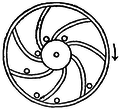檔案:EB1911 Perpetual motion Fig. 1.png
EB1911_Perpetual_motion_Fig._1.png (微格三五四矩三二三,度:七一 KB,多用網際網路副檔名之型:image/png)
此檔為維基共享資源之共傳,可另策用也。 於共庫上檔述之示。
概
| 述EB1911 Perpetual motion Fig. 1.png |
English: Illustration from the 1911 Encyclopædia Britannica, article Perpetual Motion. Theoretical study of the perpetual wheel
We assume that the ball rolls and slips on the inner track of the wheel. The various inventoried losses of this motor are : Rolling friction losses ( Rrf ) of the ball on the inner track of the wheel and resulting from local deformation of the raceway under the weight of the ball, Power losses due to sliding of the contact surfaces of the ball and raceway (ω' is greater than ω), Loss of two ball bearings installed on the axis of the wheel.
Balance of forces along y1 axis :
Balance of forces along x1 axis :
We have the following relationship between Rrf and R :
Then, it comes:
Expressing the following equalities :
It comes then :
In this formula, the following terms are known: F magnet, m, g, α and θ. α is the angle of the rolling friction. The combined gravity and magnetic forces cause an unbalance of the rolling ball which is not compensated by an equal and opposite reaction force. The ball is forced to rotate and this rotation drives the main wheel by means of rolling friction force. Due to violation of Newton's third law, there is creation of excess positive energy from potential energy supplied by static magnetic and gravitic fields. Static potential energy is thus converted into kinetic energy by that perpetual wheel.
Calculation of drive torque The drive torque is equal to Tdrive = Fresulting x r , soit:
Calculation of inlet power Excepting parasitic movements linked to instantaneous instabilities of operation and taking the assumption of a constant angle theta, one can verify that the magnetic and gravity forces provide no power to mechanism. These two forces are involved only in maintaining an unstable state. Then:
Calculation of drive power The sliding coefficient rslip of the ball on the inner race of the wheel is expressed by the following formula: , then : Let's calculate the drive power : Pdrive = Tdrive . ω'
with Let's calculate the outlet power : Poutlet = Fresulting . R . ω
It has to be noted that: and :
Calculation of COP (coefficient of performance) Pnet outlet = Poutlet- Pwheel friction losses Pwheel friction losses = 1% Poutlet and Pnet outlet = 0,99 Poutlet
Calculation of COE (coefficient of energy)
Numerical application r = 0,015 m - R = 0,15 m - g = 9,81 m/s² - θ = 30° - tan α = 0,001 - r slip = 10% - ω = 60 rpm = 6,2832 rd/s - B = 0,4 T - μ0 = 4 π 10-7 - μr = 1,0000004 - S = 0,01 x 0,01 = 10-4 m² Fmagnet = 6,366 N m = 0,014 kg Fresulting = 5,442 N Tdrive = 0,041 mN Pdrive = 5,700 W Poutlet = 5,130 W P rolling losses = 0,570 W P net outlet = 5,078 W P wheel friction losses = 0,052 W COP = ∞ COE = ∞ |
| 期 | |
| 碼 | Encyclopædia Britannica, 1911 |
| 作者 | Internet Archive: https://archive.org/details/Encyclopedia_Britannica_1911_Complete |
權
| Public domainPublic domainfalsefalse |
| This image comes from the 13th edition of the Encyclopædia Britannica or earlier. The copyrights for that book have expired in the United States because the book was first published in the US with the publication occurring before January 1, 1929. As such, this image is in the public domain in the United States. |  |
說明
在此檔案描寫的項目
描繪內容 繁體中文
成立或建立時間 繁體中文
1911
檔誌
揀日尋檔。
| 日時 | 縮 | 度 | 用戶 | 註 | |
|---|---|---|---|---|---|
| 今 | 二〇一六年四月二二日 (五) 〇九時五二分 |  | 三五四矩三二三(七一 KB) | Kastrel | User created page with UploadWizard |
檔所繫者
下頁連本檔:
總文之用
下他共筆連本檔:
- en.wikisource.org上之用
補註
此檔補註,製者所添,如相機、掃描之器;後若更檔,補註不誠也。
| 水平解析度 | 三七點七九 dpc |
|---|---|
| 垂直解析度 | 三七點七九 dpc |

